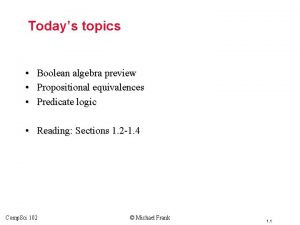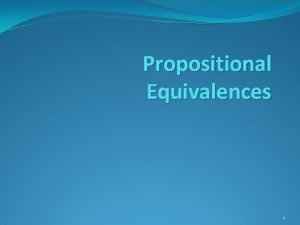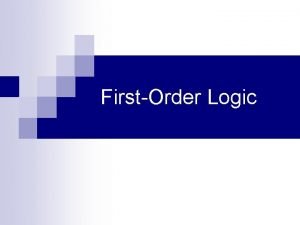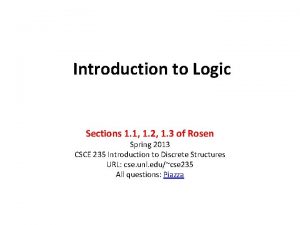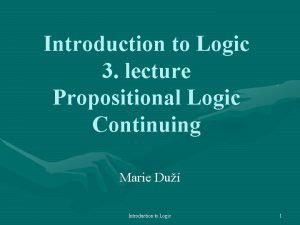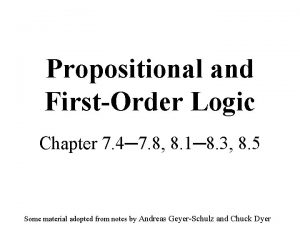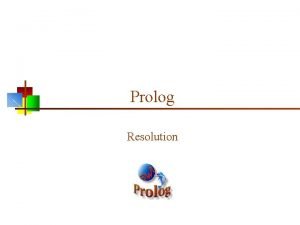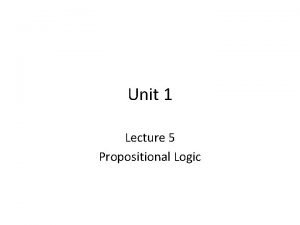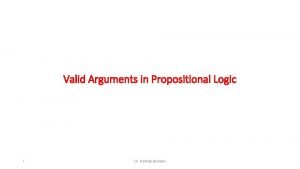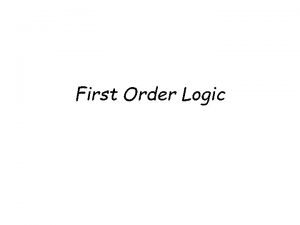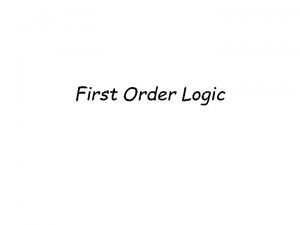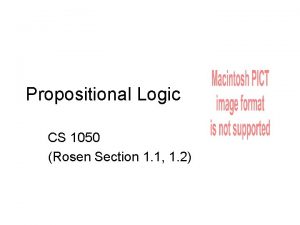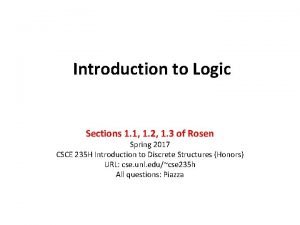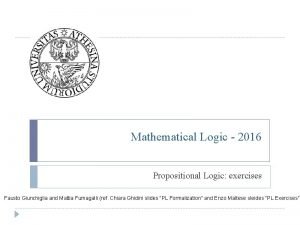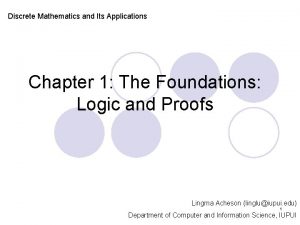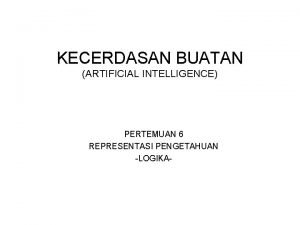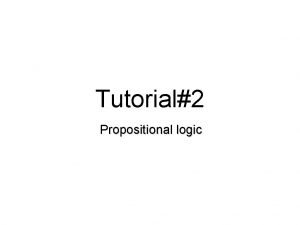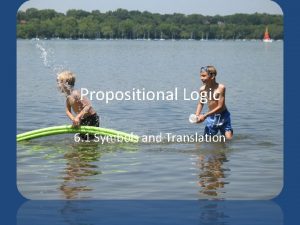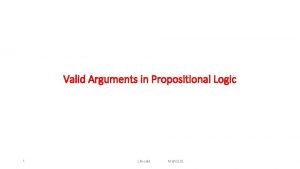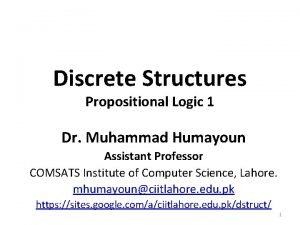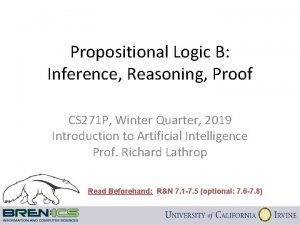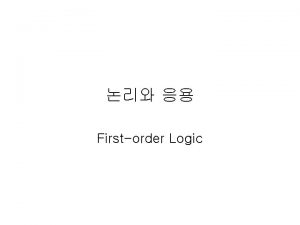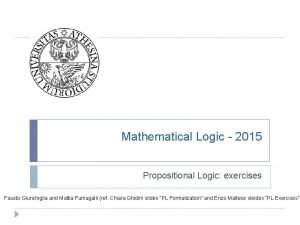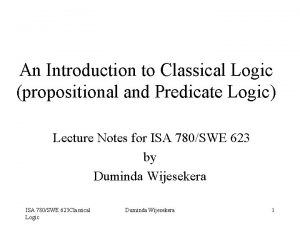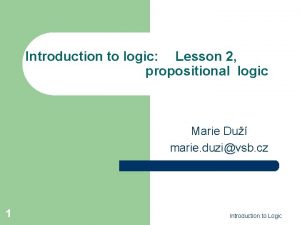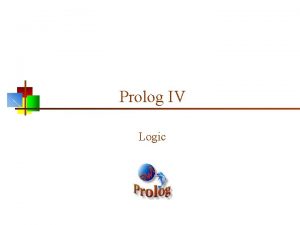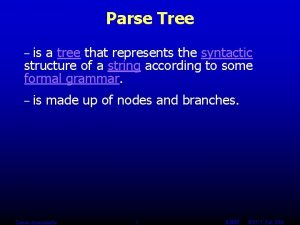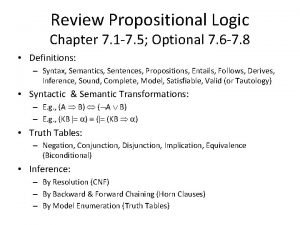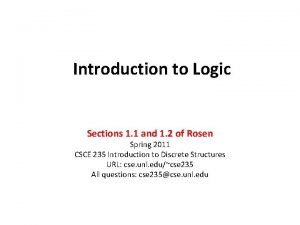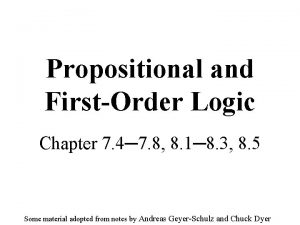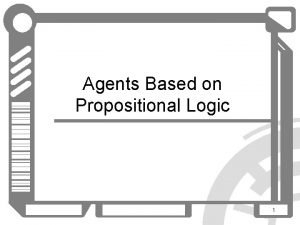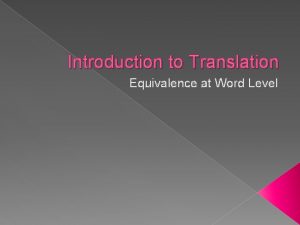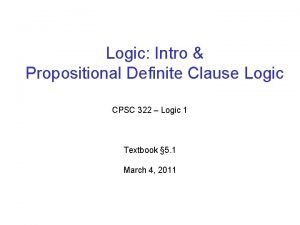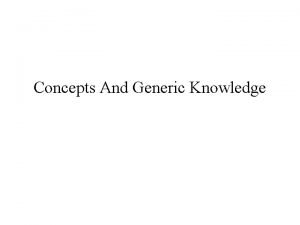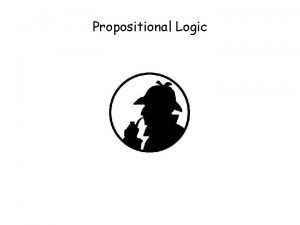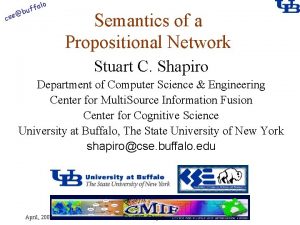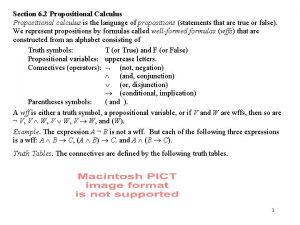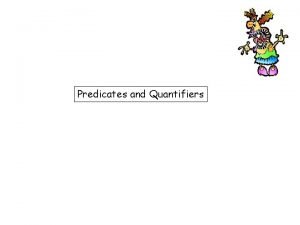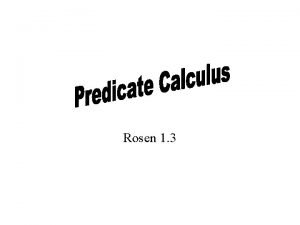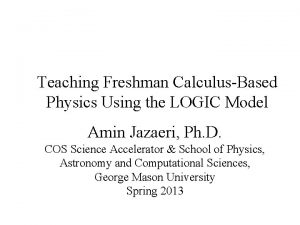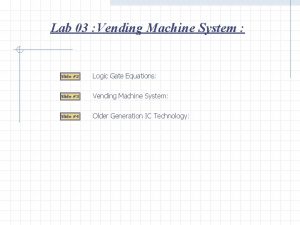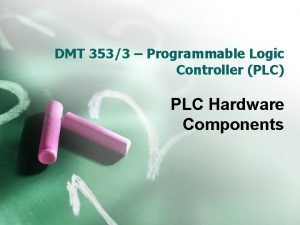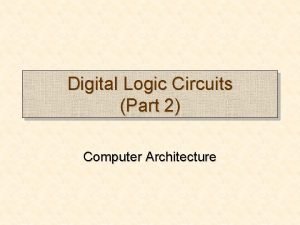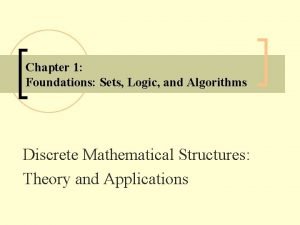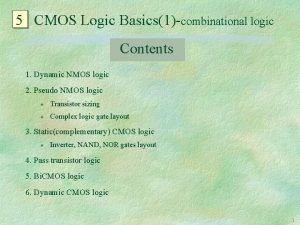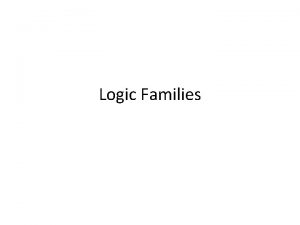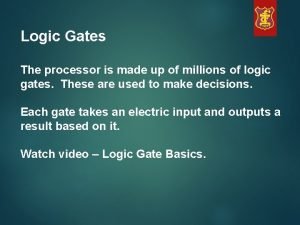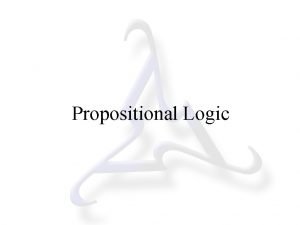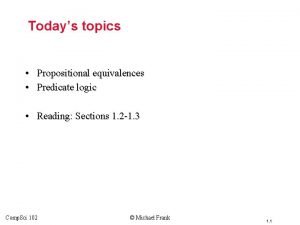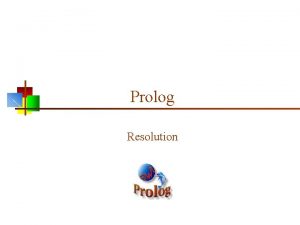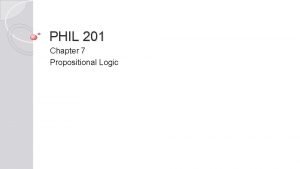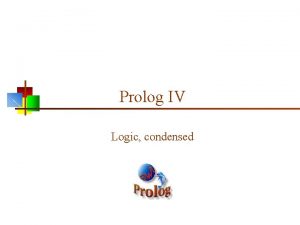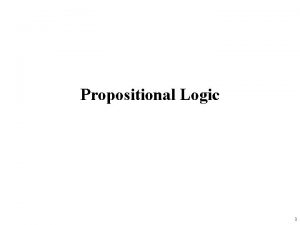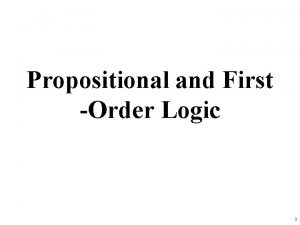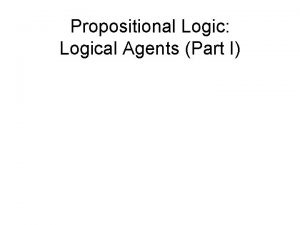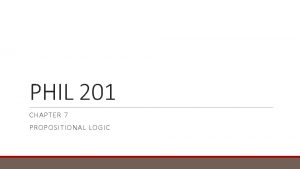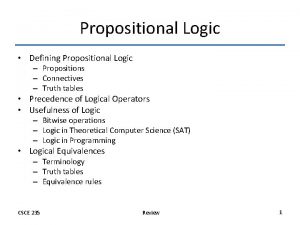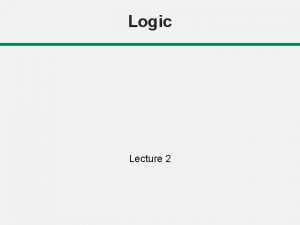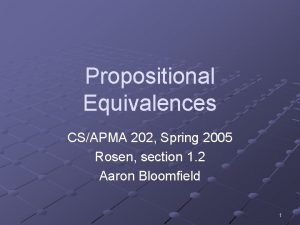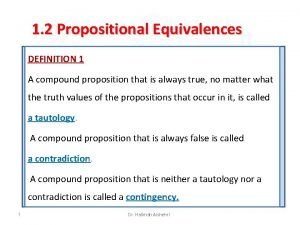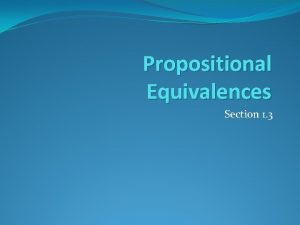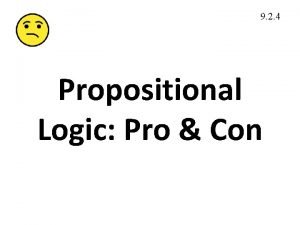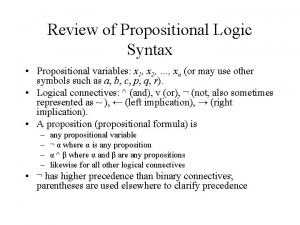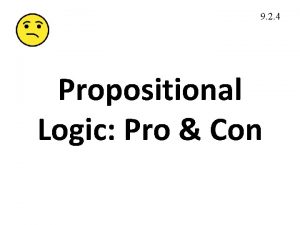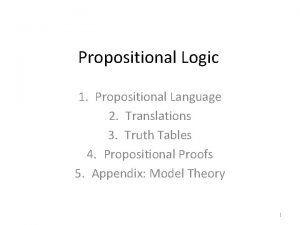Propositional Equivalences 1 What is Logic 2 Logic































































- Slides: 63

Propositional Equivalences 1

What is Logic? 2 • Logic is the study of reasoning - the nature of good (correct) reasoning and of bad (incorrect) reasoning. Its focus is the method or process by which an argument unfolds, not whether any arbitrary statement or series of statements is "true" or accurate. Logicians study and analyze arguments, premises, inferences, propositions, conditional statements, and symbolic forms. • http: //www. philosophicalsociety. com/logic. htm#logicdefined

3 • Logic is the formal systematic study of the principles of valid inference and correct reasoning. • It is used in most intellectual activities, but is studied primarily in the disciplines of philosophy, mathematics, semantics, and computer science.

PROPOSITION • A statement that makes a declaration that is either true or false, NOT BOTH 4

Examples of Propositions • A) Port-of- Spain is the capital of Trinidad and Tobago. • B) Rain is falling • C) 4 + 5 = 12 5

Are the following propositions? Explain your response. • 6

Propositions • The truth/ Falsity of a statement is called its “TRUTH VALUE” 7

Notation • Letters are used to represent propositional statements. • Example: “The rain is falling” can be represented by p. 8

Notation • When a proposition is true, the truth value is written as “T” OR “ 1”. However, when it is false it is written as “F” or “ 0”. 9

Simple v. s. Compound Statement 10 • Simple = a statement that cannot be decomposed into a separate statement. E. g. “ The sky is blue” • Compound = a statement that can be decomposed into two or more simple statements. The truth value of a compound statement is determined by the truth value of each statement.

Truth table • This is a convenient way of representing the truth value of statements. • Example to follow. 11

Negation • 12

Example • “The rain is falling” = p • “The rain is not falling” = ~p 13

Truth Table P 14 ~P T F P ~P T F F T

Connectives • These are used to form compound propositions, or simply to join simple statements to create a compound proposition. 15

Conjunction (AND) • 16

Disjunction ( OR ) • This is the compound proposition when two simpler statements are connected by “or”. It is denoted by the symbol “v”. • Let’s focus on the two: conjunction and disjunction. 17

Symbols that are used Connective Symbol AND Type of Statement Conjunction OR V Disjunction NOT ~ Negtion

Truth Table for p ^q • Recall that the conjunction is the joining of two statements with the word and. • The number of rows in this truth table will be 4. (Since p has 2 values, and q has 2 value. ) • Think of a light switch with two switches!!

Truth Table for p ^q p q T T F F T F p^q

Truth Table for p ^q p q p^q T T F F T F T F F F

Truth Table for p ^q • For p ^ q to be true, then both statements p, q, must be true. • If either statement or if both statements are false, then the conjunction is false. p q p^q T T F F T F T F F F

How to construct a Truth Table? • A logical statement having n component statements will have 2 n rows in its truth table. • If the statement has 2 components or propositions the number of rows must be • 22 = 4 rows. 23

Activity • Construct a Truth Table with 3 propositions, p, q and r • If a compound statement consists of n individual statements, each represented by a different letter, the number of rows required in the truth table is 2 n. 24

Activity • Construct the truth table for: p ˄ (~ p ˅ ~ q) 25

Construct the truth table for: p ˄ (~ p ˅ ~ q) p q ~p ~q ~p˅~q T T F F F T T F T F F T T T p ˄ (~ p ˅ ~ q)

Construct the truth table for: p ˄ (~ p ˅ ~ q) p q ~p ~q ~p˅~q T T F F F T T F T F F T T T p ˄ (~ p ˅ ~ q)

28 p q ~p ~q ~p˅~q p ˄ (~ p ˅ ~ q) T T F F T T T F T F F F T T T F

Exercise – Use a Truth Table to show the following • p˄ q • ( p ˄ r) ˅ ( q ˄ p) 29

De Morgan’s Laws 30 ~(p ^ q) ≡ ~p v ~q. Augustus De Morgan ~(p v q) ≡ ~p ^ ~q. 1806 -1871 Very useful in constructing proofs This truth table shows that De Morgan’s Second Law holds

De Morgan’s Laws 31 Augustus De Morgan 1806 -1871 p q ~p T T F F F T T F F T

De Morgan’s Laws 32 Augustus De Morgan 1806 -1871 p q ~p ~q T T F F T F T T F F F T T

De Morgan’s Laws 33 Augustus De Morgan 1806 -1871 p q ~p ~q (p^q) T T F F T T F F T T F

De Morgan’s Laws 34 Augustus De Morgan 1806 -1871 p q ~p ~q (p^q) ~(p ^q) T T F F T F T F T T F T

De Morgan’s Laws 35 Augustus De Morgan 1806 -1871 p q ~p ~q (p^q) ~(p ^q) ~p. V~q T T F F T T F F T T

Conditional Statements • 36

Conditional Statement • 37

Truth Table for p q • Recall that conditional is a compound statement of the form “if p then q”. • Think of a conditional as a promise. • If I don’t keep my promise, in other words q is false, then the conditional is false if the premise is true. • If I keep my promise, that is q is true, and the premise is true, then the conditional is true. • When the premise is false (i. e. p is false), then there was no promise. Hence by default the conditional is true.

Truth Table for p q p q T T F F T F T T

“If you participate in class, then you will get extra points. " When the antecedent is true and the consequent is true, p → q is true. If you participate in class (true) and you get extra points (true) then, The teacher's statement is true. When the antecedent is true and the consequent is false, p → q is false. If you participate in class (true) and you do not get extra points (false), then, The teacher’s statement is false.

“If you participate in class, then you will get extra points. " If the antecedent is false, then p → q is automatically true. If you do not participate in class (false), the truth of the teacher's statement cannot be judged. The teacher did not state what would happen if you did NOT participate in class. Therefore, the statement has to be “true”. If you do not participate in class (false), then you get extra points. If you do not participate in class (false), then you do not get extra points. The teacher’s statement is true in both cases.

Conditional Statements • Converse • Inverse • Contrapositive 42

Converse, Inverse, and Contrapositive Conditional Statement p→q If p, then q Converse q→p If q, then p Inverse p→ q Contrapositive q→ p If not p, then not q If not q, then not p

Contrapositive • The contrapositive states that if the conclusion is false then the hypothesis is false. i. e. the contrapositive of p → q looks like : • (~q) → (~p) • Draw the Truth Table for (~q) → (~p) 44

Truth Table for ~q ~p p q T T T F F ~p ~q ~q ~p

Inverse • This states that if p is false then q is false. • In other words give the proposition p → q the inverse would be (~p) → (~q). • Work out Truth table for the Inverse compound statement above. 46

Converse • This states the reverse of the conditional statement. • I. e. if we have the proposition p → q, then its converse would be q → p. • Work out the truth table for the compound statement above. 47

Equivalent Propositions 48 • Two propositions are equivalent if they always have the same truth value. • This is determined by the output column of the truth table. We write this as p≡q (or p⇔q)

Equivalent Propositions 49 • One way to determine equivalence is to use truth tables • Example: show that ¬p ∨q is equivalent to p → q.

Equivalent Propositions • Example: Show using truth tables that implication is equivalent to its contrapositive • Solution: 50

Show Non-Equivalence 51 • Example: Show using truth tables that neither the converse nor inverse of an implication are equivalent to the implication. • Solution: p q ¬p ¬q p →q ¬ p →¬ q q → p T T F F T T F T F F T T T

Biconditional Statements • 52

Biconditional Statements • 53

Truth Table 54 p q T T F F F T

Exercise • Page 17 Ex 23 55

Tautologies, Contradictions, and Contingencies 56 • A tautology is a proposition that is always true. • Example: p ∨¬p • A contradiction is a proposition that is always false. • Example: p ∧¬p • A contingency is a compound proposition that is neither a tautology nor a contradiction P ¬p p ∨¬p p ∧¬p T F F T T F

Key Logical Equivalences Identity Laws: , Domination Laws: , Idempotent laws: , Double Negation Law: Negation Laws: ,

Key Logical Equivalences (cont) Commutative Laws: Associative Laws: Distributive Laws: Absorption Laws: ,

More Logical Equivalences 59

Equivalence Proofs 60 • Instead of using truth tables, we can show equivalence by developing a series of logically equivalent statements. • To prove that A ≡B we produce a series of equivalences leading from A to B. • Each step follows one of the established equivalences (laws) • Each Ai can be an arbitrarily complex compound proposition.

Equivalence Proofs Example: Show that equivalent to Solution: 61 is logically

62

Equivalence Proofs Example: Show that is a tautology. Solution: 63
 Propositional equivalences
Propositional equivalences Tautology contingency or contradiction
Tautology contingency or contradiction First order logic vs propositional logic
First order logic vs propositional logic First order logic vs propositional logic
First order logic vs propositional logic First order logic vs propositional logic
First order logic vs propositional logic Pros and cons of propositional logic
Pros and cons of propositional logic Propositional logic
Propositional logic Rezolution v2
Rezolution v2 Logic in discrete mathematics
Logic in discrete mathematics Propositional logic signs
Propositional logic signs What is mathematical system
What is mathematical system Propositional logic
Propositional logic Propositional logic
Propositional logic Valid arguments in propositional logic
Valid arguments in propositional logic Biconditional
Biconditional Biconditional proposition examples
Biconditional proposition examples Xor in propositional logic
Xor in propositional logic Logical equivalence cheat sheet
Logical equivalence cheat sheet Propositional logic exercises
Propositional logic exercises The proposition ~p ν (p ν q) is a
The proposition ~p ν (p ν q) is a Propotional logic dapat digunakan untuk..
Propotional logic dapat digunakan untuk.. Propositional logic examples and solutions
Propositional logic examples and solutions Logic translation symbols
Logic translation symbols Valid
Valid Discrete math propositional logic
Discrete math propositional logic Propositional logic notation
Propositional logic notation ___________ is the limitation of propositional logic
___________ is the limitation of propositional logic Propositional logic exercises
Propositional logic exercises Reflexive axiom
Reflexive axiom Well formed formula
Well formed formula Proposition examples sentences
Proposition examples sentences Parse tree propositional logic
Parse tree propositional logic Propositional logic examples
Propositional logic examples Applications of propositional logic in discrete mathematics
Applications of propositional logic in discrete mathematics Logical equivalence laws examples
Logical equivalence laws examples Implies in propositional logic
Implies in propositional logic Percept sentence
Percept sentence Agents based on propositional logic
Agents based on propositional logic At word level
At word level Propositional
Propositional Generic knowledge
Generic knowledge Logical equivalence
Logical equivalence Propositional network
Propositional network Propositional network
Propositional network Propositional calculus
Propositional calculus How a predicate function become a propositional function?
How a predicate function become a propositional function? Propositional function examples
Propositional function examples Majority circuit
Majority circuit Combinational vs sequential logic
Combinational vs sequential logic Combinational logic sequential logic 차이
Combinational logic sequential logic 차이 Tw
Tw If x = 0 and y = 1, which output line is enabled?
If x = 0 and y = 1, which output line is enabled? Project management plan example
Project management plan example Bos logic
Bos logic Fresh man logic
Fresh man logic Logic vending machine
Logic vending machine Programmable logic controller
Programmable logic controller Digital logic and computer architecture
Digital logic and computer architecture What is a nonserual sequential logic in project
What is a nonserual sequential logic in project Laws of mathematical logic
Laws of mathematical logic Ganged cmos
Ganged cmos Dcvs logic
Dcvs logic Characteristics of logic family
Characteristics of logic family Processor logic gates
Processor logic gates
